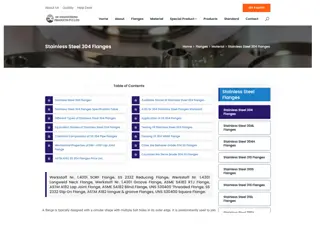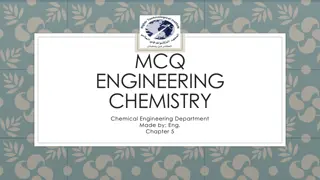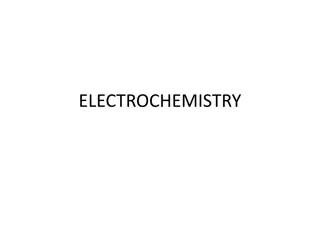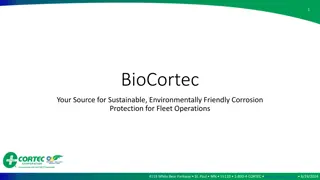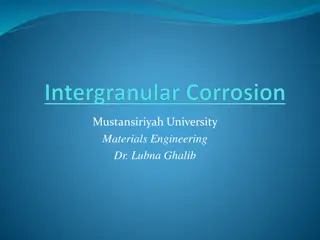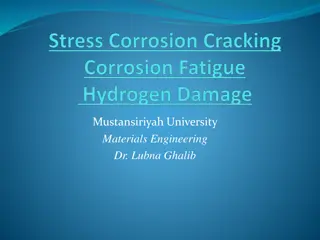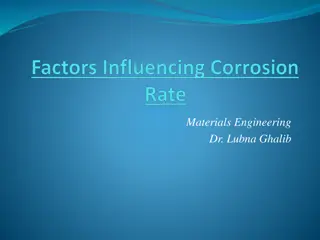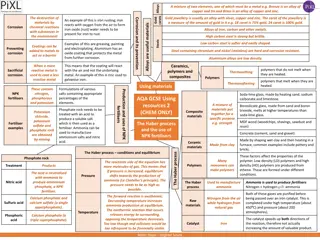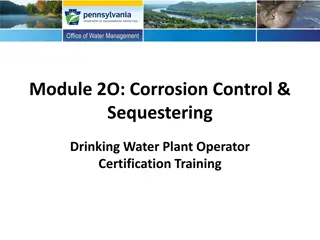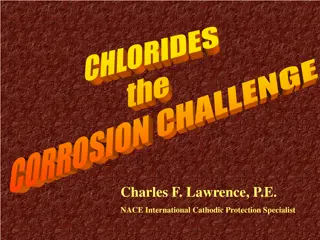Understanding Corrosion and Electroplating in Chemistry
Delve into the fascinating world of corrosion and electroplating with a detailed exploration of their principles, processes, and methods of protection. Learn about atmospheric corrosion, immersed corrosion, chemical corrosion, underwater corrosion, and underground corrosion. Discover the electrochemical theory behind corrosion and gain insights into the essential processes involved. Explore the significance of electrolysis, Faraday's laws, cathode current efficiency, and the basics of electroplating. Uncover the importance of cleaning articles and the specifics of electroplating chromium and anodizing. Enhance your knowledge of these key topics in the field of chemistry.
Download Presentation

Please find below an Image/Link to download the presentation.
The content on the website is provided AS IS for your information and personal use only. It may not be sold, licensed, or shared on other websites without obtaining consent from the author. Download presentation by click this link. If you encounter any issues during the download, it is possible that the publisher has removed the file from their server.
E N D
Presentation Transcript
WEL WEL- -COME COME Dr. D . N. Zambare Dr. D . N. Zambare Department of Chemistry , Kisan Veer Mahavidyalaya, Wai (Satara)
Chapter 3 :Corrosion and Electroplating Contents 3.1 Introduction to Corrosion 3.2 Electrochemical Theory of Corrosion 3.3 Factors affecting on Corrosion i) Position of metals in electrochemical series on the basis of standard reduction potential ii) Purity of metal iii) Effect of moisture iv) Effect of oxygen (differential aeration principle) v) Hydrogen overvoltage 3.4 Methods of Protections of Metals from Corrosion 3.5 Electroplating 3.5.1 Electrolysis 3.5.2 Faraday s laws 3.5.3 Cathode current Efficiency 3.5.4 Basic principles of electroplating 3.5.5 Cleaning of articles 3.5.6 Electroplating of chromium 3.5.7 Anodising
3.1 Introduction Corrosion: Corrosion is the process by which the metals go back to their natural state in which they are found to occur in nature i.e. any process of chemical or electrochemical decay or destruction of a metal due to surrounding medium is known as corrosion. 1. Atmospheric Corrosion: When metal is in direct contact with the surrounding air and the system which is get formed as a solid-gas heterogeneous system, is known as atmospheric corrosion , 2. Immersed Corrosion: When metal is in direct contact with liquid medium and the system which is get formed as a solid-liquid heterogeneous system, is known as immersed corrosion , (i) Chemical Corrosion, (ii) Under water Corrosion (iii) Underground Corrosion
(i) Chemical Corrosion Chemical corrosion occurs as an effect of a chemical or electrochemical reaction between a metal and its surrounding liquid medium, containing acids, bases, salts and many other solutions in chemical industries that act as a corroding medium. (ii)Under water Corrosion Under water corrosion is a immersed type of corrosion, corrosion of underwater type includes corrosion of parts of machinery during manufacture of chemicals, corrosion of submarine structures, and corrosion in water pipes, heating systems, steam boilers etc. (iii) Underground Corrosion Underground corrosion is similar to under water corrosion but somewhat more complicated due to the presence of various salts in the soil. Underground corrosion includes corrosion of metal structures and ferrous metal in concrete, underground pipes etc.
3.2 Electrochemical theory of corrosion Principle: "Corrosion of metals in any medium is essentially a heterogeneous chemical reaction, for which water is quite essential. The theory is based on the Nernst theory of electrolytic solution pressure Corrosion is an electro-chemical process that involves anodic dissolution of the metal . When a metal is immersed in water, there is a tendency for the metallic atoms to become ions and to go into the solution, leaving their electrons on the metal. Thus it gives the metal a negative charge. The process is called de-electronation or oxidation.
Explanation (Working) According to this theory, certain areas of the metal which are being corroded act as anodes while certain other areas of the metal act as cathodes. At anode: Metal is oxidised and pass into solution as metallic ions; where oxidation is removal of electrons. i.e. Fe Fe2+ + 2 e (Anodic Oxidation Reaction) At cathode: The reaction is the reduction ions, which are liberated due to slight ionization of water. Here reduction is gain of electrons. i.e. H2O H+ + OH- (Ionization of water) H+ + e H (Cathodic Reduction Reaction) H + H H2 Overall reaction is Fe + 2 H+ H2 (g) ..(4) ... (1) ..(2) ..(3)
In the corrosion of iron or steel, cathodic reaction is thus liberation of hydrogen gas. When hydrogen is liberated, the the OH- ions left behind will migrate towards the anode. The Fe2+ and Fe3+ ions meet the OH- ions moving in the opposite direction and thus a precipitate containing Fe (OH) 2 and Fe (OH) 3 is obtained. Fe2+ + 2 OH- Fe (OH) 2 4 Fe (OH) 2 + 2 H2O + O2 4 Fe (OH) 3 Carbon dioxide from the atmosphere converts the precipitate into hydroxy carbonates, which is nothing but the rust. Fe (OH) 2 + CO2 Fe (OH). (HCO3) (Final rust) Fe (OH) 3 + CO2 Fe (OH)2 .(HCO3 (Final rust) etc.
3.3 Controlling Factors (i)Position of metal in the electro-chemical series, A series of elements arranged in order of their decreasing standard reduction potential is called electro-chemical series Position (placement) of the metal in electrochemical series, decides whether the metal will be anodic or cathodic. Metals which become anode undergo corrosion. The metal (element) which is at the top having obviously, higher electrode potential (E value) acts as Anode whereas the metal (element) placed at lower position acts as a Cathode .
Electrode Electrode Reaction Li K 2+ + 2e 2+ + 2e Ca Na Mg Al Zn Fe2 Cd Co Ni Sn 2H 2++ 2e Hg Ag Pd Pt Au E (298 K) V 3.045 2.925 2.920 2.890 2.840 2.713 2.356 1.676 0.762 0.440 0.402 0.282 0.257 0.137 0 + ++ e ++ e Anodic Li | Li K | K Ba | Ba Sr | Sr Ca | Ca Na | Na Mg | Mg Al | Al Zn | Zn Fe | Fe Cd | Cd Co| Co Ni | Ni Sn | Sn Pt, H2 | H Li K Ba Sr + 2+ Ba Sr Ca Na 2+ + 2e Mg 3+ + 3 e 2+ + 2e + + 2e 2+ + 2e 2+ + 2e 2+ + 2e 2+ + 2e + + 2e Cu 2+ + 2e + + e 2+ + 2e 2+ + 2e 3+ + 3e 2+ 2+ 2+ + 2e + + e + 2+ 3+ Al Zn Fe Cd Co Ni Sn H2 2+ 2+ 2+ 2+ 2+ 2+ + 2+ Cu | Cu Hg | Hg Ag | A Pd | Pd Pt | Pt Cu 0.34 0.796 0.799 0.915 0.98 1.36 2+ Hg Ag Pd Pt Au g+ 2+ 2+ Au | Au3+
(ii) Purity of Metal: Pure metals are hardly corroded. Corrosion of metals is greatly influenced by the presence of impurities in the metal. This is attributed to the formation of a voltaic cell between the impurity and the metal. The impurities which have low over potentials have marked marked effect in the spread of corrosion. The impurity acts as a cathode while metal becomes anode.
(iii) Effect of Moisture: According to Vernon, iron will not rust if air is dry and relative humidity is below 50% When the relative humidity is between 50 to 80%,fine rust, say Fe (OH) 2, is formed but it does not spread over the surface extensively and hence corrosion is not severe. When the relative humidity becomes 80% or above, the pores of rust become unable to retain more water and the film of water spreads over the surface and corrosion spreads rapidly. primary product Fe (OH) 2 is oxidised to Fe (OH) 3 and then to ferric oxide, Fe2O3 a red rust.
(iv) Effect of Oxygen (Differential Aeration Principle): The direct attack of oxygen on iron causes rusting or corrosion. This ancient concept has been proved to be incorrect. When oxygen comes in contact with metallic surface, usually a very thin film of oxide is formed and it protects the metal from further corrosion. This process is called as self-stifling. Rusting is no doubt an oxidation but iron will not rust in the atmosphere of oxygen. It is observed that the areas with low concentration of oxygen (air), act as anode with respect to areas with high concentration of oxygen (air). The areas with high concentration act as cathode.Thus, current flow between anode and cathode occurs. In simple words, the process of decay (corrosion) takes place.
The principle may be demonstrated by setting up a cell with two clean similar iron strips immersed separately in different compartments separated by a porous partition. The electrolyte is 0.5 M KCl solution, free from dissolved oxygen, which is previously removed by boiling the solution. Now if oxygen is bubbled around one iron strip and if the strips are connected by a wire, then the other strip corrodes. When the two strips are connected through milliammeter, an electric current is recorded on the milliammeter thereby showing that aerated strip becomes cathodic and the unaerated strip becomes anodic. Further the solution in the aerated compartment becomes alkaline on account, of the accumulation of OH- ions as H+ ions have been discharged. On the other hand, Fe3+ ions are accumulated in the unaerated compartment.]
(v) Hydrogen over voltage. This difference between the potential of evolution of hydrogen at the surface of a given metal and that at the surface of platinized platinum is known as hydrogen over-voltage, or hydrogen over-potential. At the initial stage, in a galvanic cell, H+ ions gain electrons at the cathode and H atoms are formed. These atoms combine to form H2 molecules which may form an invisible film on the cathode. H+. + e- (from cathode) H H + H H2 (g) As a result of the formation of hydrogen film, a back potential (i.e. polarization) is set up and hydrogen atoms go back into the solution as hydrogen ions and force metallic ions, to redeposit on anode.
e.g. Fe2+(aq) + 2 H(g) Fe(s) + 2 H+(aq) To induce this effect some extra voltage is required to evolve hydrogen at a particular metallic cathode than that is required to evolve hydrogen at platinum black as cathode. This difference between the potential of evolution of hydrogen at the surface of a given metal and that at the surface of platinized platinum is known as hydrogen over-voltage, or hydrogen over-potential.
3.4 Methods of protections of metals from corrosion: 1. Alloying of the Metals: 2. Polishing the Surface: 3. Removal of impurities: 4. Removal of Strains: 5. Formation of Phosphate Coating: 6. Production of Insoluble Oxide Coatings: 7. Coating with Non-Metallic Materials: 8. Electroplating: 9. Making the Metal Cathodic by using high E.M.F: 10. Non-Electrolytic Methods of Protection:[ Metal Spraying (Metalizing)Cementation ,Hot Dipping ,Galvanizing]. 11. Controlling external condition:
3.5 Electroplating Introduction: Electroplating is the branch of electrometallurgy in which depositions or coatings of metal/metals in the form of thin layers are give (made) over the original surface of any object by the process of electrolysis. In electroplating, metallic and in some cases non- metallic articles are covered with a metal coating
3.1 : Electrolysis, Faradays Laws, Cathode Current Efficiency 3.5.1 Electrolysis: In electroplating, electrolysis plays an important role. It is the process in which electrical energy is used to bring about the chemical change. Electrolysis involves the application of potential difference through suitable electrodes immersed in the solutions in the metallic salts (i.e. metallic ions). Metallic ions migrate towards cathode and are deposited on it, while at anode; metallic ions are formed passing ions into solution. 3.5.2 i) Faraday s laws: The scientist Faraday suggested the relationship between amount of the substance deposited or dissolved and the quantity of electricity in the form of two laws of electrolysis as follows: ii) First law of electrolysis: It states that the amount of substance deposited or dissolved at any electrode is directly proportional to the quantity of electricity passed through the electrolyte. iii) Second law of electrolysis: It states that when the same quantity of electricity is passed through different electrolytes arranged in series, then weights of substance deposited or dissolved at the respective electrodes are proportional to their chemical equivalent weights.
3.5.3 Cathode current Efficiency: maintains metal ion content fixed or constant during plating. Anode must be made of highly pure metal. Article to be plated is made as cathode. Current is supplied from an external source. The electroplating generators supply either 6 or 12 volt high amperage current. The weights of the substances deposited are dependent on the cathode and anode efficiencies which are given by, ??.?? ? ? ????????? ????????? ??.?????????? ???? ???. ???x 100 Generally soluble anode of the metal to be deposited is preferred because it Cathode efficiency = ??.?? ? ? ????? ????????? ??.?????????? ???? ???. ??? x 100 Anode efficiency = = practice it is impossible to attain 100% efficiencies. But at least they must be equal even if below 100% (may be 90 or 95%) which will maintain metal ion fixed or constant. If cathode efficiency > anode efficiency, the both becomes poorer in metal content which affects the deposition. If anode efficiency > cathode efficiency, both becomes rich in metal contain. Then all the metal ions try to discharge at once which makes disturbance in discharge and ultimately results into bad deposit. Thus, there must be proper control on both the efficiencies, so that proper rate of discharge of ions and crystals growth is maintained. This is done by using appropriate current densities. In both electrodes have 100% efficiency, that is the identical condition. In
3.5.4 Basic principles of electroplating: 1.Current density (C.D.): Current density is measured or expressed in terms of amperes per unit area of electrode surface. It is unit of A/sq. ft. or A/ dm2. At low C.D. s the discharge of ions occurs slowly so that the deposits obtained are uniform and coarsely crystalline. If the C.D. is increased, the rate of formation of nuclei will be greater and the deposit will become more fine-grained. At very high currents the solution in the vicinity of the cathodes will be depleted in the ions required for discharge and hence, the crystals will tend to grow outwards towards the region of higher concentration due to which deposit consists of trees , nodules and protruding crystals. If the C.D. exceeds the limiting values for the given electrolyte, then along with the deposition of metal, hydrogen will be evolved which interferes the crystal growth and hence , rough, porous or spongy and black deposits may be obtained. Hence, limiting value of C.D. must be used.
2.Nature and concentration of electrolyte: The effect of electrolyte concentration and of C.D. are found to be complementary, by increasing the concentration or by agitating the solution, higher C.D. s can be used before coarse deposits are formed or before hydrogen evolutions occurs with the spongy or dark deposits. The effect of concentration on the rate of nucleus formation is uncertain. It is observed that the increase of concentration tends to give firm, concentration, but the improvement in the deposit is due to an increasing the rate of growth of crystals over the cathode surface. When fine grained deposits are required, a low metal ion concentration is desirable, so that no crystal can grow rapidly. This metal ion concentration can be reduced by (a) use of dilute solution, (b) use of a complex salt and (c) use of common ion. Thus, (i) Electrolyte or salt must be highly soluble,(ii) It should have conductivity, (iii) It must be stable and should resist the atmospheric oxidation or hydrolysis, (iv) It must dissolve anode easily, (v) It must produce compact and adherent deposits. 3. Temperature: Increase of temperature has two effects which oppose one another. In the first, the diffusion is favoured, so that the formation of rough or spongy deposits at relatively high C.D. s is inhibited. In the second, rate of crystal growth, favouring a coarse deposit, is increased. Further increase of temperature decreases hydrogen over-voltage and facilitates the evolution of gas as well as the precipitation of basic salts. At moderate temperatures, the first effect predominates, so that the deposits ar improved but at higher temperatures deterioration is observed. At moderate temperatures (warm or hot condition), (i) solubility of the salt increases which helps in using higher C.D. and high concentrations, (ii) conductivity increases which reduces the tendency of breeing and hence, lowers the cost of electricity. 4. Colloidal matter (Addition agent): In many instances, the metal normally deposits on the cathode in the form of relatively large crystals, but the presence of very small amounts (0.05g per litre or 5* 10-5kg/dm3) of colloidal matter i.e. addition agent, often results in the production of smooth, fine-grained and micro-crystalline deposits. The various addition agents used are : gelatin, peptone, agar, glue, gums, rubber, casein, alkaloids, dye-stuff, sugars and camphor.
5. Electrolyte (Nature of anion): The physical form of the deposited metal depends on the nature of the anion of electrolyte. For example, lead deposit from lead nitrate solution is rough, but smooth deposits are obtained from silico fluoride and borofluoride solutions. The valence state of the metal may affect the nature of the deposit e.g. from plumbic solutions (Pb++) lead is deposited in the spongy form, whereas relatively large crystals are formed in plumbous solutions (Pb+). The difference in this behaviour of different electrolytes may be due to the possibility of formation of colloidal matter which serves to give a fine-grained deposit. It is observed that smooth deposits are generally produced from solutions of complex ions, particularly cyanides. The most important example is silver which is obtained as a very coarse deposit from nitrate solutions while cyanide solutions give the familiar smooth deposits of electroplate . Some workers consider that crystal nucleus formation is favoured by the extremely small concentration of sample. 6. Basic metal and throwing power: metal used as the cathode, it has also some effect on the crystal growth. It is apparent that in many instances, the general orientation of the crystals is a continuation of that in the basis metal. Although the external form of a deposited metal is rarely affected by the basis
Throwing power: It is the property of a solution by virtue of which relatively uniform deposit of metal may be obtained on a cathode of irregular shape. The good throwing power is supposed to be dependent on the following factors: (a) The rate of increase of cathode potential with current density: If preferential deposition should take place at any part of the cathode, the effective C.D. will be higher here than on the reminder of the cathode. If this higher C.D. requires much increase ed potential, there will be a tendency for the C.D. to be automatically reduced at the part under consideration and so will give good throwing power. In general the addition of colloidal matter improves the throwing power of solution, but increases of temperature and agitation have the opposite effect. (b) Conductance of solution: If the conductance of electrolyte is low, the current lines will tend to concentrate on the parts of the cathode nearest the anode and the throwing power will be bad. With a solution of good or higher conductance, there will be no particular preference, as far as these factor is concerned, for one portion of the cathode over any other and will thus, improve the throwing power. (c) Distance between anode and cathode: If distance between them is small, then parts of article near the anode will be deposited heavily and hence, placing of anode and cathode is important. When two or more cathodes are used, amount deposit ed on the cathode near the anode is higher than that away from the anode. The nature of electrolyte also decides that deposition on different cathodes. This can be called as covering power of electrolyte for cathode.
7. pH or Hydrogen ion concentration and simultaneous discharge of cations : If the solution is highly acidic (lower pH value), the fine and bright deposits are obtained. But this brightness gives a warning that the solution is near the danger point at which there is the occurrence of cracked or curled deposits. As metals at the top of the emf series are more active than those of lower, they would plate out (deposit) of the solution with difficulty. For example, if H+ ions are present in the electrolytic bath, they should plate out easily than the ions of metal above hydrogen. The hydrogen over voltage on zinc is high, so Zn can be deposited in acidic solutions. The overvoltage of Fe or Ni is low and hence, they can be plated out from neutral solutions. Copper is below hydrogen in the series and hence, can be deposited from acidic solutions. If solution contains two or more cations, then all the ions may discharge simultaneously on the cathode. This problem is of little importance in the formation of alloys; but it is important in electroplating of single metal. Even aqueous solutions of electrolyte contain H+ ions and they are discharged at cathode in the form of H2 gas. The evolution of H2 gas may interfere in the fine deposit. Thus simultaneous deposition takes place only when decomposition potential or cathode potential or discharge potential of potential, discharge of metal undergoing plating is favoured. at
8. Concentration and agitation or circulation: For continuous deposition metallic ions must be uniformly distributed throughout the solution. This is done by stirring the solution continuously or by rotating the cathode by means of chemical mixers. In the absence of agitation, metal ion concentration will be either low or high in the vicinity of cathode which changes the rate of discharge of ions. Agitation also sweeps away the gas evolved from the cathode surface, which otherwise may strike with deposit. Excess agitation may also have following disadvantages: (i)Insoluble impurities are brought on the surface of cathode, (ii)It favours the formation of carbonates in cyanide solution, (iii)It decreases throwing power. 9. Covering power: In some methods such as the bent cathode and the cavity scale, the behavior of the solution is decided by the extent to which the cathode is covered and it is called covering power. For the sake of convenience, this is related to throwing power and to the lowest current density at which metal can be deposited from the bath. Thus, in electroplating following points must be carefully observed. 1. Nature of anode, cathode and their potential, position of metal in emf. Series, hydrogen overvoltage. 2. Nature and concentration of electrolyte, its conductance, temperature of the bath, addition agents, agitation. 3. Proper control on current density, voltage, time of passing the current, rate of nucleation and rate of crystal growth , thickness of deposit and throwing power of solution.
3.5.5 Cleaning of articles: Metallic articles are generally covered with grease, oily material, dust particles and rust. If the surface is not thoroughly cleaned, then deposit will not perfectly adhere to the surface of article. Thus, surface must be free from foreign matter of any kind. Even a touch of finger on the prepared surface is highly objectionable. Cleaning of the metal or article involves two steps, 1. Removal of grease or oil: Grease or oily material is an organic substance; it can be converted into soluble soap by the action of an alkali like NaOH, KOH, Na3PO4, Na2CO3 etc. and can be removed. Article to be cleaned is washed with gasoline or benzene or CCl4. Article is suspended in the vapour of boiling solvent like benzene or CCl4. Vapours condense on the article, they take away grease and drop it back into the liquid below. Removal of grease is also done by electrolytic process. Article is made cathode and immersed in alkaline solution. A high C.D. of about 30-45 A/sq. ft. is used. There is evolution of H2 gas at cathode due to which grease is removed. Temperature about 50-60 C (323 to 333K) is applied for few minutes. 2. Removal of oxide or dust on the article: It is removed by the action of mineral acids like HCl, H2SO4, and HNO3. This process is known as pickling in which due to evolution of H2, oxide film is removed. Now a days electrochemical cleaning is done in which article to be cleaned is made anode in acid bath (30% H2SO4) at 60 (333K). A heavy current is passed through the solution for 10-15 minutes, during which all impurities are dissolved out. After this process, article is picked by the action of mixture of H2SO4 and HNO3 . This process is known as bright deeping. Other methods like sand blasting, wire brushing, tumbling barrels, electrolytic polishing etc. may also be used for this purpose.
Electroplating Equipment: 1. Generation of current: The direct current used in electroplating of very low voltage. For various electroplating, voltage is about 6 to 12 volts is necessary. Except for short distance, as transmission of low-voltage current is not practically possible, it is necessary to generate the direct current at the plating plant. 2. Distribution of current: The current is carried from the generator to the plating tanks over rectangular bus-bars. Usually copper bars are used due to their high conductivity 3. Electrical measuring instrument: In electroplating, the nature or character of the plated deposit depends on the current density. This current can be properly regulated by usual instruments like ammeter, voltmeter etc. 4. Tanks (Electroplating bath): For rinse tank, wooden tanks are generally used. Steel tanks are used for cleaners and alkaline solutions, lead lined tanks are used for bath containing chromic acid and H2SO4 . Rubber lined tanks are used for neutral and acid solution bath. 5. Agitation and motion plating : Agitation helps to keep the composition of the bath solution most uniform and thus, permits the use the greater C.D. Agitation by means of air is one of the simplest method but has the disadvantages that it serves to stir up sediment and causes rough deposits. 6. Circulation and filtration: If anodes used are not pure, then sludge will gradually accumulate at bottom of tank. Some sludge will remain in the suspended form. Therefore, it is necessary to filter the plating solution from time to time.
Electroplating of Chromium importance. There are two types chromium plating used for different purposes as, (I) Decorative plating where thin coating of chromium serves a brilliant and durable surface finish and (II) Industrial or hard chromium plating where heavy deposits are used to take the advantage of special properties of chromium including resistance to heat and corrosion. The electro deposition of chromium is rather recent development in the field of electroplating and it has a great commercial 1. Nature of anode: Pure chromium anodes are not used because, it has maximum anode efficiency and bath becomes saturated with chromium ions, similarly pure chromium is costly as compared with CrO3. Pb or steel anodes are used. Generally Pb is preferred as it does not contaminate the bath. 2. Nature of cathode:Article to be plated is made as cathode after cleaning it with usual method. 3. Bath composition and different reaction: Chromium trioxide( CrO3) or chromic acid is the main component of the bath solution. It supplies chromium ions during plating . CrO3 when dissolved in water forms chromic acid as, CrO3 + H2O H2CrO4 This chromic acid dissociates at definite rate and gives CrO4- - ions according to the equation H2Cr2O4 2H+ +CrO-- Exact mechanism of various reactions taking place is not fully understood. In CrO4- - ion C r has a valency +6. At cathode it is reduced to +3 by liberated hydrogen gas as, Cr +6 + 3e- Cr +3 Some of the Cr +3 ions react with chromic acid to form chromium dichromate. There is also possibility of formation of Fe2( Cr2O7)3 when iron tank is used for keeping the solution. To avoid it, tanks are generally lined with glass or SO4- - ions may be supplied from H2SO4 or Na2SO4The bath composition should be as follow: CrO3, chromic acid .. 250 gm /lit(0.25kg /dm3) H2SO4 or SO4- - radical .. 2.5 gm / lit (2.5 x10 -3kg /dm3 ) Water . 1 lit ( 1 dm3)
4. Operating (optimum) condition (a)Current density: 10 -25 A /dm2 (100 to 225 amperes per sq. ft.) (b)Temperature: 40 -45 C (313 -318 K)At this temperature range, lustrous deposits are obtained and no further finishing is necessary. If the solution is kept at room temperature, dull and hard deposits may be obtained. To ensure bright deposit and achieve maximum efficiency, ratio of concentration of CrO3 and SO4- - radical should be 100: 1 ??.?? ???3 ?? ?? ??4 ??????? =100 i.e 1 For best throwing power it should be 200:1. Under this condition cathode efficiency is low about 12.5%and therefore, proper control on solution composition, C.D., temperature is necessary. If C.D. is low, deposit may be milky, if it is high, deposit may be frosty. Hence, limiting C.D. value must be used. As insoluble anode is used it is necessary to add CrO3 from time to time to maintain required chromium content (c)Precaution: During electroplating H2 gas is liberated at cathode and oxygen at anode, which may drive out or spray acid fumes in the room. These fumes are harmful to the operator, hence, special ventilation is absolutely essential nd medical checkup for workers is necessary. 5. Bright chromium plating: Chromium plate is porous in nature and hence, it is not plated directly on iron, steel, brass, zinc etc. When chromium is plated over buffed metal, it has bluish and bright cast. Bright chromium plating with high resisting power to corrosion is obtained by plating with successive layer of Cu, Ni and finally of chromium. Thus, Ni forms intermediate coating or base plate for Cr-plating. Ni-plating itself is highly-coloured and polished and hence, no further polishing is necessary.
6. Application of Chromium-plating 1. Due to high polish, hardness, resistance to corrosion it is widely used as- (i) Decorative articles e.g. mirror, frames, rubber goods etc. (ii) Engineering articles e.g. automobile parts, crash bars, radiators, lamps etc. 2. It is widely used in final finishing operation of many articles. 3. It is also used to prepare printing plates, dies, wrist watch p ins etc. because of its smoothness and hardness. 4. For various engineering applications heavy and hard deposits of chromium have been developed or obtained by plating Cr directly on the base metal without Ni layer. Such hard deposits have special properties such as resistance to heat, low coefficient of friction, resistance to were and corrosion. This hard chrome deposition has come into force during last 15-20 yrs., details of process is not fully known. Patented zonax chrome solution and hychrome solution are used with following optimum conditions. Temperature: 45 to 50 (318 to 323K), C. D.: 2 to 3 amp./ sq. inch. Voltage: 6 to 7 volt, efficiency 12 to 15% Time: 2 to 3 hours depending on the thickness of deposit.
Role of Brighteners The use of addition agent is very important in the development of solutions for bright plating. Solutions of these agents are widely used especially in the plating of Zn, Cd, Ni, Cu etc. This procedure greatly decreases the cost of buffing of the metal and prevents reduction in the thickness of the plate. F or example, copper deposited from a cyanide bath containing small quantity of gelatin consists of alternate parallel bands of Cu and gelatin, which possess excellent reflating power. Similarly Ni deposited from bath containing special brightness show this rhythmic banding. There are two classes of brightness as, (i) Anionic viz. sulphonamides, aromatic sulphonates etc. and (ii) Cationic viz. aromatic amines, aldehydes, ketones etc. An anionic brightner alone gives a deposit equal in brightness to the original cathodic surface. But both anionic and cationic brightners together lead to an enhanced brightness which increases the plating thickness. As described earlier, the use of some colloidal substances like proteins and peptones have an immediate effect on the deposit because of their spontaneous adsorption on the surface. In general, in presence of colloids and complex salts, there will be the formation of smooth, bright and excellent deposits with good physical properties.
3.5.7 Anodising: of electroplating except that Al is made anode instead of cathode. Thus, anodising is the process which gives the coating of oxide film on the surface of Al or its alloys.Such coating is almost similar to that obtained by electroplating. Like coating has ability to absorb different coloured dye-stuffs permanently which helps in making decorative articles. Al is made anode and oxidation is conducted in a manner similar to that of electroplating. During anodizing oxygen is evolved at anode which is responsible for the coating of oxide film. Anodising can be carried out by the following two processes. This process is not an electroplating but oxidation is carried in a manner similar to that organic solvent like gasoline, CCl4 or benzene or by treatment in alkaline solution (15% NaOH). After this article is washed with water. It is then placed in electrolytic bath as anode. Lead-lined or rubber-lined tank itself acts as the cathode while when rubber-lined tank is used, cathode of lead is employed. Tank is filled with 7 to 60% H2SO4, temperature is kept about 15 to 30 , (288 to 303K) time of passing the current is about 10 to 15min. (600 to 900sec.), H2SO4 solution is prepared in water free from chloride. For 15% H2SO4, C.D. should be 12 to 30 apm/ sq. ft. and voltage should be 12 to 16 volts. 1. Sulphuric acid process: Here article is first freed from oil, grease by washing it with For architectural anodizing where extremely tough to corrosion is required, anodizing time may be increased upto 60 minutes (3600sec.) after removing the article from the bath, it is washed with water and dipped in NH3 to neutralize any acid. Oxide films are highly absorptive and permit colouring by any dye.
2. Bengough or chromic acid process: Here 3% chromic acid solution is used in the bath. Solution is prepared in water free from chloride. Temperature of bath is 40 (313K). The cleaned article is made anode and it is subjected to change in voltage from 0 to 50 volt. For aeroplane parts 40 min.(2400sec.) time is used. Then article is removed, washed and dried in usual manner. In this method, steel tank is used and it is serves the purpose of cathode. method, electrolyte is an acid mixture with pH range 4 to 4.8 containing 10% Na2Cr2O7, 2 to 5% monosodium phosphate. The C.D. should be 5 to 10 A/sq. ft., Temperature: 50 . Time of passing the current: 30 to 60min. Now a day, anodizing is also used to obtain coatings on Mg metal. In this Application of Anodising1. It is used for the production of protective and decorative films on Al.2. Anodised plate has ability to absorb dyestuffs which enables to use it in jewelry, kitchen wares etc. 3. Very thin film coatings are used in rectifiers and condensers. 4. Protective oxide film of Al and its alloy can be used in electrical insulation.
THANK YOU ! THANK YOU !



